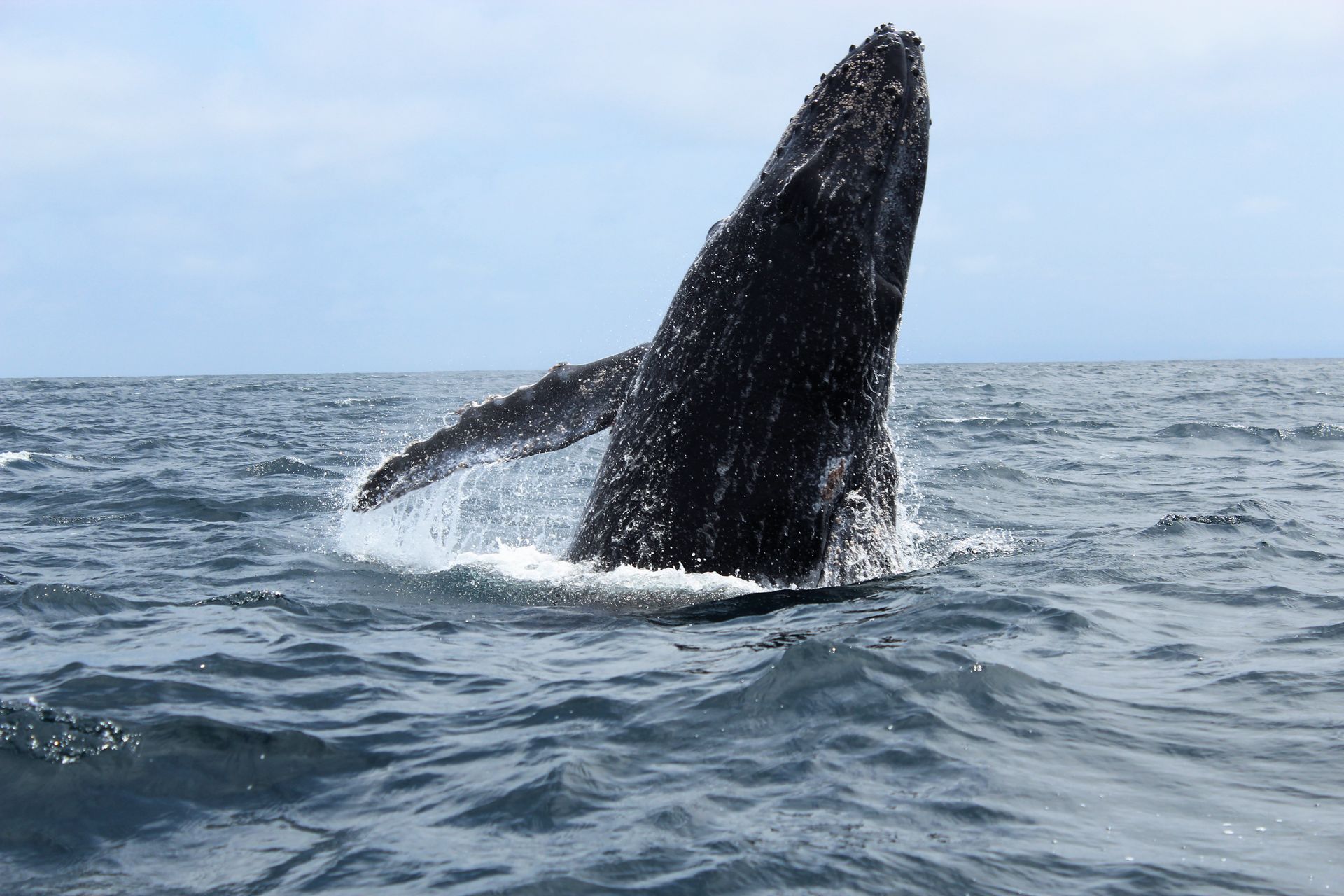2023 TOP 10 BLOG
VJEL Staff Editor: Em Green
Faculty Member: Sarah Reiter (Reiter co-authored in her capacity as an adjunct Professor of Law and any views here are her own and do not reflect the opinion of the NEAQ)
Whale v. Lobster: Conflicting Interests Between Protecting the North Atlantic Right Whale and Supporting New England’s Commercial Lobster Industry
On August 6th, 2022, a young North Atlantic Right Whale (NARW), #4501, was spotted off the coast of New Brunswick, Canada. Appearing in good health, #4501’s appearance was catalogued and touted as a bright point for the future of this critically endangered species. Weeks later, in late August, #4501 was spotted again, this time with fishing gear wrapped across his back.
For many, lobster and New England are synonymous. The region is defined by its fishing culture, within its own borders and throughout the greater United States. Beyond a cultural identity, the lobster industry has a significant impact on both the state and national economy. In 2014 the National Marine Fisheries Service (NMFS) issued a biological opinion (BiOp) that incurred the wrath of both conservation groups and the fishing industry. The opinion inspired extensive litigation that continues to this day.
Consider the Whale
Since 2017, 91 NARWs have been documented dead, seriously injured, or sporting sublethal injuries and illness, in a phenomenon scientists refer to as an Unusual Mortality Event (UME). Less than 350 NARWs remain, primarily due to entanglements and vessel strikes. Experts claim that only “quick and decisive action from humans” can ensure the species survival. Moratoriums on fishing within “protected zones” as well as requirements to mitigate potential harm have drawn criticism and legal challenges from fisheries and state/local governments. Without immediate protection the future of the NARW looks grim.
Consider the Lobstermen
NOAA compiles data on commercial landings, the “weight of, or revenue from fish” sold for profit, in an annual report. In 2021, Maine reported a record $724,949,426 in landed value from lobster harvesting alone. Ocean acidification, warming waters, overall decrease in biodiversity have led to dramatic changes in fish populations and behavior. As a result of the warming waters, over the past 10 years an increasing portion of lobster fishing occurs 3 or more miles offshore, further into NARW territory. Many lobstermen see new protective regulations as another injury imposed on an industry already struggling to keep its head above water.
Consider the Law
Section 7 of the Endangered Species Act (ESA) requires federal agencies to ensure that any action authorized, funded, or carried out by a federal agency will not “jeopardize the continued existence of” or result in the destruction or adverse modification of a listed species or its habitat. If there is likely to be an effect the federal agency must prepare a biological opinion. If a proposed plan moves forward with a “no jeopardy” opinion, it can only do so with an incidental take statement (ITS) that outlines the impact on the protected species and limitations on allowable takes.
Under the Marine Mammal Protection Act (MMPA) marine mammals that are in danger of extinction as a direct result of human activities are entitled to certain protections. Absent a permit or permitted incidental take, activities that result in the “taking” of an endangered or “depleted marine mammal are prohibited. To minimize mortality and serious injury (M/SI) an agency must implement a plan to reduce M/SI below a species’ potential biological removal level (PBR) within six months. The PBR is the level at which population remains stable. The PBR for NARW is 0.7.
Conservation groups have pursued litigation that alleges NMFS did not meet its duties under these two statutes and failed to properly protect the NARW. Under the Administrative Procedures Act (APA), a court must overturn agency actions that are “arbitrary and capricious.” If an agency’s action will be upheld if there is a “rational connection between the facts found and the choice made.” The Fishing industry claims that NMFS violated this statute and that its opinions and rules have not met the required standard.
Consider the Court
The 2018 the D.C. District Court held that the 2014 BiOp was invalid for failure to include an ITS. In the BiOP, NMFS wrote that the operations of federal fisheries would likely result in an annual M/SI of 3.25 for NARW. The agency was unable to issue the required ITS, because under the MMPA taking even one NARW exceeds the PBR and threatens the survival of the species overall. The agency got creative and instead set “numerical triggers” which, if reached, would reinitiate consultation. The Court did not bite and ordered NMFS to reissue a biological opinion with a valid ITS by May 31st, 2021. In the meantime, the Court allowed the fisheries to continue operating.
On May 27, 2021 NMFS issued its new BiOp that contained an ITS authorizing zero lethal takes. The same year they also promulgated the 2021 Final Rule which aimed to reduce NARW M/SI well below the PBR by 2030 and included a “conservation framework.”
In Center for Biological Diversity v. Raimondo, conservation groups argued that the new ITS was still invalid and that the Final Rule did not meet requirements to reduce M/SI within the statutory timeframe. The Court agreed. NMFS was not excused from its lawful duty simply because it was challenging to comply. The Court held that if the if the “action under review could not be authorized under the MMPA” then NMFS should have revised the action. The court also held that the 2021 Final Rule was invalid for failing to reduce M/SI to required levels within six months. Again, the fisheries were allowed to continue operating while the court entertained potential remedies.
In Maine Lobstermen’s Association v. NMFS, lobstering associations alleged that the 2021 BiOp was invalid because it went too far in its protections and unfairly targeted lobstermen. The Court was not swayed and held that NMFS met its obligations under the APA and had not acted arbitrarily or capriciously. The agency used peer-reviewed models to predict harm to the NARW and appropriately used its expert judgment to allocate that harm.
Consider the Future
The young NARW mentioned at the beginning of this article will likely die from its injuries. At first glance, the most recent litigation seems like a resounding win for conservation groups. Yet despite finding in favor of greater protections for NARW, courts have consistently refused to halt fishery operations. At each stage an agency is simply allotted more time to revise its opinions and rules. Conservation groups have to balance the frustration of “winning” in court but watching the fisheries continue to operate and harm the NARW.
2021 saw the most valuable harvest in the history of Maine’s lobster fishing industry. And yet the future of the industry is murky due to the combined effects of climate change and increasing awareness. The Monterey Bay Aquarium recently placed American lobster on its “red list,” which discourages consumers from purchasing the crustacean based on environmental concerns. The Marine Stewardship Council suspended certification of Maine lobster following the recent litigation, prompting Whole Foods to cease selling it. Lobstering associations decry the harm and threat to their industry that increased regulations could cause. Beyond the sheer fiscal contributions of the industry, it can be hard to quantify the cultural value of a multi-generational juggernaut.
This pattern of prolonged litigation perpetuates an “us v. them” dichotomy and creates unsatisfactory solutions for both conservationists and lobstermen. To survive in this climate afflicted reality both groups would benefit from cooperation. One potential solution, ropeless/on-demand fishing, presents an example of such an opportunity. NOAA’s roadmap to develop on-demand fishing emphasizes the desire for partnership with federal fisheries and make this technology accessible and effective. To meet conservation goals, ropeless fishing must develop beyond the experimental phase. Those working to reduce NARW deaths through on-demand fishing benefit from the industry feedback and data collection. And the fishing industry, which is struggling to reach sustainability, benefits in the long run from technologies that might keep them in business.
Instead of seeking cooperative solutions, the very lobstermen who lost their case in federal court, alongside New England politicians, successfully lobbied for an amendment to the 2023 Omnibus Bill. The amendment allows the U.S. lobster fishery to delay taking any significant conservation actions that would help protect the NARW. This dangerous precedent makes it clear that Congress is willing to overlook the statutorily required “best available scientific data” in favor of special interests and political pressure. In a move that casts a pall of uncertainty over the entire future of environmental protections, Congress has made it clear that statutory compliance is a commodity, not a necessity.


